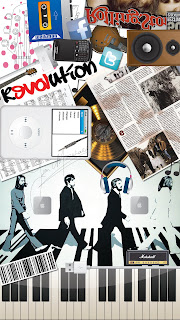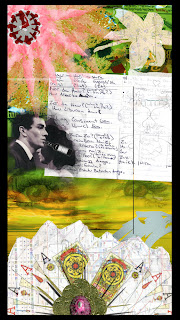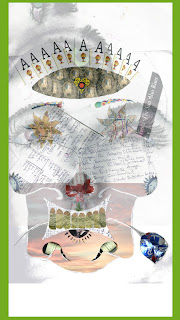Click to view Digital Media website.
Take a moment to survey student work,
and gain a perspective of the world
you've managed to stumble into!
Below is the online syllabus.
You will have a hard copy too.
★ ★ ★ ★
A R T 2 4 5 - 1 0 0 1 . D i g i t a l M e d i a I
1 : 0 0 - 3 : 4 5 P M , C F A 2 0 8
Instructor : Benjamin Poynter
Email : benjipoynter@gmail.com
Phone : (405)-410-5988
Office Hours : 12 - 1 PM Monday / 1 - 4 PM Friday / By Appointment [CFA 208]
Course Description
The primary objective of ART 245 is to provide an introduction to the critical studies of digital media. Students will learn how to analyze the foundations, cultural forces and context that are synthesized in contemporary media art and technology. This will be accomplished through a balanced investigation of both the history and theory surrounding digital media while at the same time being involved in the creation of visual art through conceptual utilization of the computer and related technologies. This course emphasizes the personal development of critical thinking, artistic, and technical ability. You'll be challenged with controlled experiments using a variety of digital processes towards visual art production. This course presents students with opportunities to work with digital imaging, animation, video/sound/time-based media, the internet and social media as creative areas of discourse. This class is the introductory hud to the Digital Media program and is a prerequisite for all other course offerings required for the studio major and minor.
Prerequisites
+At least one art studio course
(visual foundations, beginning photography, drawing, etc.)
+No computer experience required.
Required Texts, Course Materials
Readings: Specific Xeroxed articles, tutorials, and other online source material will be assigned in proper progression. Materials : Portable flash/external hard drive.
Course Philosophy
The Digital Media program exists as part of the larger Art Studio program for the Department of Art – all studio programs currently focus on the development of a contemporary approach to studio art practice and theory. Digital Media emphasizes an artistic, experimental, and technical approach to learning to utilize media systems for the creation of art.
The intent is to provide an intensive learning environment that considers the computer as a broadly flexible tool much like the paintbrush available to the contemporary artist. Specific project assignments will also push you to consider the conceptual use of such tools. This is a thoroughly hands-on course. You will be expected to learn how to use the tools at your disposal – this is not a software-training course.
You will learn in this class by doing – students will be given broad introductions to a variety of applications and devices as incorporated into project assignments. Learning to use these complex graphics programs, online technologies, and computer peripherals takes much dedication of time and a flexible attitude towards experimental practice and learning.
Learning to become proficient utilizing new technologies is accomplished through both individual and shared experience. What you derive from this class in terms of technical learning will largely be defined by the amount of time you spend exploring and experimenting and taking advantage of the support resources available to you through the Digital Media Studio, the Dynamic Media Lab (@ One) in the KC, and via online tutorials. Bearing that in mind, classes that are not Digital Media I will be occupying the lab at external hours as well. Plan around this.
Finally, you will be challenged constantly to consider just what you are doing with these new tools - the true challenge of this course is to engage in the creation of critical, challenging, thoughtful, meaningful, and conceptually sound creative experiments.
Techniques
You will be introduced to the following basic programs and systems: Adobe Photoshop Soundtrack and/or Audacity Final Cut Pro/iMovie Website/Blog Development Flatbed scanners Digital cameras Laser printer Color inkjet printers, small and large format, and much more.
Course Requirements
1) Each student will complete a total of 7 regular class projects followed by the creation of a general studio atmosphere for the investigation of individual and/or group projects. All projects will be uploaded and accessible to the instructor and students on individual student blogs that will be created by the second week of the course. Each project posted online will also feature a brief artist statement describing your approach to the specific assignment. i.e. a paragraph.
While you will have your individual blog, below is the address of the official blog which will be continually updated with relevant assignment information and useful artifacts-
2) Critiques. Selected projects will be discussed and critiqued in open sessions. Talking about your work and others is a crucial aspect of creating art. Learning to articulate verbally and in writing, just what your work is about, is just as important as the actual making of the work. Think of the separation between "form and concept" (what it looks like/what it "is") or especially if they can be the same. The ideas shared in an open critique will help us all learn from each other and greatly increase our ability to understand our creative practice. Be aware of when comments on peers' blogs are due. A post of ALL of individual blogs in class will be available week 2!
3) For each non-tutorial reading you are required to create two questions for discussion based on that week's reading. These are to be posted to your blog prior to that day’s reading discussion. Do not simply reiterate facts. Strive for critical thinking in questions!
4) Attendance is mandatory at all class sessions. The policy behind unexcused absences beyond 2 : you will begin losing points to final grade. Emergencies require documentation.
5) Each student will require a minimum 8 gb FLASH DRIVE to transfer their files. Other supplies will be individualized for each student. THIS IS REQUIRED BY THE SECOND WEEK OF CLASS.
(Note : If external hard drive is acquired, make note to properly "partition" it for both Mac and PC sides for operation on both. A personal tutorial may be given to help explain.)
6) Grading: Students will be graded according to how well their participation in reading discussions and creative projects reflect an understanding and willingness to engage with the techniques, issues, and practices covered in class. Students should expect to spend at least six hours a week outside of class on their work. The final grade is broken down as follows:
•40% Studio Projects - 700 pts (7 projects x 100 pts ea)
•10% Questions for reading discussion on blogs. - 175 pts (7 readings x 25 pts ea)
•9% Participation/critiques, discussions, attendance. - 150 pts (15 weeks x 10 pts per week)
•10% Written lecture and exhibition reviews. - 180 pts (3 reviews x 60 pts ea)
•14% Final Paper - 245 points
•17% Final Project - 300 points
TOTAL POSSIBLE: 1750 POINTS
GRADING RUBRIC:
1750-1575=A
1575-1400=B
1400-1225=C
1225-1050=D
1050-0000=F
7) Each student is REQUIRED to write a one-page critical analysis for three different art calendar events throughout the semester and have it turned in on the alloted date at the end of the semester. One of these events is absolutely necessary to be the CADRE at Haldan Art Gallery at Lake Tahoe exhibition ( URL : http://www.facebook.com/events/446870038712861/?ref=25 ). A designated date in the semester will be planned on a Friday between the two Digital Media courses, afternoon and evening, so we may convoy together to Lake Tahoe if desired! An official art calendar of events should be available and posted by Week 2. Week 3 at latest.
8) Blog Participation: All assignments, large or small, MUST be documented weekly on the class blog! In addition, share links and discuss pertinent issues. Website portfolio: Each student will be creating a website/portfolio blog as an archive of all projects created in this course – this site will serve as the repository for all of your class projects and writing assignments created in this course and any future courses taken through the Digital Media Program. We will go over the creation of your blog on the first day of the class.
9) Laboratory Workshops: A Digital Media lab technician by the name is Dillon McGillivray [dmcgillivrary@unr.edu] will be available 11-4 outside of class time Mondays-Thursdats to give related workshops specific to technical issues surrounding individual projects. It is highly recommended that students take full advantage of this resource! In addition, the instructor will be giving personal guidance and workshops. Always during office hours and, when designated, special Sundays 1-4.
10) Cell phones and PDA's - Please do NOT use your cell phones for texting or any other purposes during class times - please put them away. If a snapshot is needed badly enough in lecture, ask me first. If I see you texting or surfing with it in class, I will confiscate your phone.
11) Course communications. I will be using email extensively to communicate important information to the class. I will be using the email that is available to me through the MyNevada system. If you do not know or are not sure which e-mail the University has posted to this system, please check and be sure you have an email that you check regularly so you will receive all class messages! Check the primary Art 245 blog as well for updates.
Computer Access
Fortunately, in the aftermath of an ongoing financial crisis with budget cuts to the University, the Digital Media Studio has a better selection of hardware to work with in the facility. It is up to date and ready (with patience and care) to be used by the student body. This is a streamlined, neutral sized laboratory with a healthy number of student workstations.
In recognition of the fact that we cannot provide a workstation for each student during scheduled class times, we will be working from a lecture/lab model that requires all student work to be completed outside of our scheduled class period. All student projects are to be completed during available lab hours in the Digital Media Studio, on your own computers or in the Knowledge Center’s Dynamic Media Lab. The media lab of the Knowledge Center’s Dynamic Media Lab as well has capable staff on site to assist students. You will be assigned a digital access code for after-hours access to the Digital Media Studio by the end of the second week of the term. Your official password to log-in to lab computers-
User : Art 245. Password : Art. Very complicated. Contact for any discrepancies.
Before reading the planned itinerary, note it is more readable on the hard copy.
D A T E
|
E V E N T ( I S S U B J E C T T O C H A N G E )
|
D U E
|
1.21 [WK1]
|
NO CLASS [MLK]. Reading 1 [Walter Benjamin] & Project 1 [Digital Diptych Montage] posted onto main blog. And how to make blog!
|
n/a
|
1.28 [WK2]
|
'Analog' Introductions. The Syllabus. Introduce Project 1 and Establish a Conceptual Theme. In-Class Team PS Exercise
|
Your Personal Class Blog / External Flash - Hard Drive
|
2.4 [WK3]
|
Discuss Reading 1 and critique Project 1. Project 2 [Stop Motion Frame Animation] posted with in-depth look. Live demo.
|
Project 1 / Reading 1 and Questions
|
2.11 [WK4]
|
Critique Project 2. Establish roles installing in Project NV gallery. Project 3 [Audio for Animation and Collaboration] in-depth look.
|
Project 2 / Comments on Project 1 Posted to Others
|
2.18 [WK5]
|
NO CLASS [PRES]. Continue on Project 3 and Project NV install. Reading 2 [Video Art] posted. Semester essay topic introduced.
|
n/a
|
2.25 [WK6]
|
Critique Project 3 and Project NV gallery! Project 4 [Art Video Emulations] posted. In-Class Team Video Exercise.
|
Project 3
|
3.4 [WK7]
|
Discuss Reading 2. Project 4, in-depth look. Additional in-class workshop towards enhancing video skills.
|
Reading 2 and Questions / Comments on Big Collab'
|
3.11 [WK8]
|
Critique Project 4, in an out-of-class location! Project 5 [The Crowdsourcing Event] and Reading 3 [Postproduction] posted.
|
Project 4
|
3.18 [WK9]
|
NO CLASS [SPRING BREAK]. Be solidifying essays and art calendar events. Aside that, party on dude.
|
n/a
|
3.25 [WK10]
|
Essay Group 'Alfa' presents. Discuss Reading 3. Go more in-depth into Project 5 and observe progress among groups.
|
Reading 3 and Questions / Essay Group 'Alfa'
|
4.1 [WK11]
|
Essay Group 'Bravo' presents. Critique Project 5. Project 6 [Into the 3D World, Part 1] and Reading 4 [New Aesthetic] posted.
|
Project 5 / Essay Group 'Bravo'
|
4.8 [WK12]
|
Essay Group 'Charlie' presents. In-depth look into Project 6. Watch and discuss the film Digital Nation.
|
Essay Group 'Charlie' / Comments on Proj' 5 & 6
|
4.15 [WK13]
|
Essay Group 'Delta' presents. Critique Project 6. Project 7 [Into the 3D World, Part 2] and final meeting-project itinerary posted.
|
Project 6 / Essay Group 'Delta'
|
4.22 [WK14]
|
Discuss Reading 4 and present 'evidence' of the New Aesthetic in our city. Go in-depth into Project 7 and plan for the finale.
|
Reading 4 and the New Aesthetic Examples
|
4.29 [WK15]
|
In-class 3D world [Second Life] demo and trip to the @One Dynamic Media Lab for a large workshop in the 3D avatar world.
|
Semester Art Calendar Event Write-Ups ( All 3 )
|
5.6 [WK16]
|
Critique Project 7. Final 'analog' goodbyes and celebration before the 'digital world' final meeting.
|
Project 7
|
[FIN, WK 17]
|
Final Meeting (Exact Time-Date to be Determined). A reflection and discussion of what was conquered all throughout.
|
Your Digital Presence
|
Statement on Academic Dishonesty: For example, "Cheating, plagiarism or otherwise obtaining grades under false pretenses" constitute academic dishonesty according to the code of this university. Academic dishonesty will not be tolerated and penalties can include canceling a student's enrollment without a grade, giving an F for the course or for the assignment. For more details see http://www.cis.unr.edu/ecatalog/Default.aspx?catalog_list_id=388
Statement of Disability Services: For example, "Any student with a disability needing academic adjustments or accommodations is requested to speak with me or the Disability Resource Center (Thompson Building, Suite 101) as soon as possible to arrange for appropriate accommodations."
Statement for Academic Success Services: For example, "Your student fees cover usage of the Math Center (784-443 or www.unr.edu/mathcenter/ ), Tutoring Center (784-6801 or www.unr.edu/tutoring/ ), and University Writing Center (784-6030 or http://www.unr.edu/writing_center/). These centers support your classroom learning; it is your responsibility to take advantage of their services. Keep in mind that seeking help outside of class is the sign a a responsible and successful student."
Statement on Audio and Video Recording: Surreptitious or covert video-taping of class or unauthorized audio recording of class is prohibited by law and by Board of Regents policy. This class may be videotaped or audio recorded only with the written permission of the instructor. In order to accommodate students with disabilities, some students may have been given permission to record class lectures and discussions. Therefore, students should understand that their comments during class may be recorded.
★ ★ ★ ★
So welcome!




















